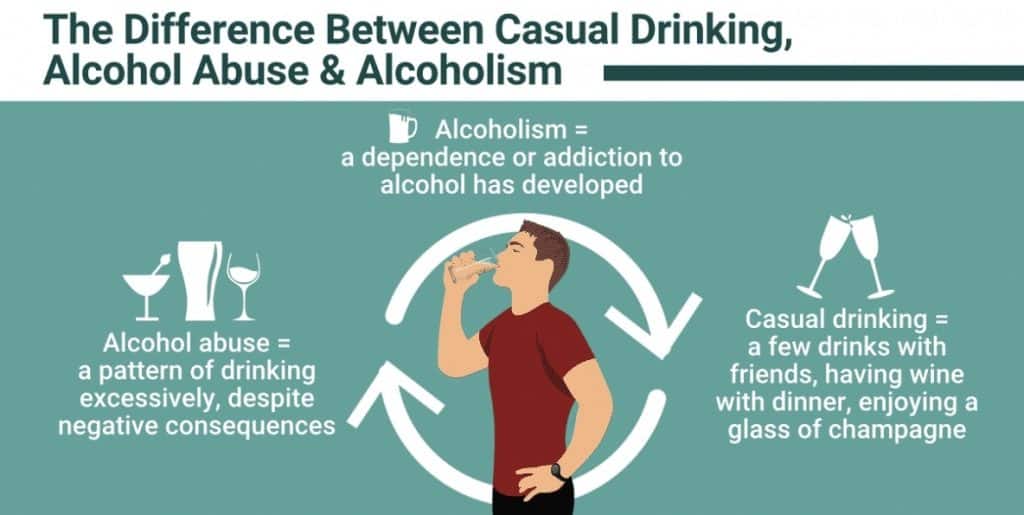
Being an alcoholic or having an alcohol use disorder (AUD) involves a problematic level of drinking that begins to affect a person’s social, emotional and physical health. Though there is no singular cause behind alcohol addiction, many different factors can contribute to its development. The disease of addiction targets people regardless of their sex, gender, race, religion or socioeconomic status, but learning about the condition can help shed light on the causes of alcoholism and possible solutions.
Around 14.1 million adults and 414,000 adolescents in the United States had an alcohol use disorder in 2019. In Colorado, where The Recovery Village at Palmer Lake is located, the prevalence of past-year alcohol use disorder was 14.6% (or 86,000 people) in 2019. This rate is higher than both the regional average (11.7%) and the national average (9.8%).
People with the condition may not fully understand AUD and what causes alcoholism, so seeking out a professional opinion and treatment options is always recommended to limit the risks.
What Is Alcoholism?
People often use the term “alcoholic” or “alcoholism” to refer to someone who is addicted to alcohol. In clinical practice, the term “alcohol use disorder” is used to describe someone with an alcohol addiction. Alcohol use disorder is an official diagnosis included in the Diagnostic and Statistical Manual of Mental Disorders. It is a legitimate medical condition that causes changes in the brain and makes it difficult to stop drinking.
This Season, Give Yourself the Gift of a Fresh Start.
Whether you are struggling with addiction, mental health or both, our expert team is here to guide you every step of the way. Don’t wait— reach out today to take the first step toward taking control of your life.
Signs of an Alcoholic
When someone develops alcoholism, there are some specific signs that can suggest they are addicted to alcohol. These signs include:
- Strong alcohol cravings
- Being unable to cut back on alcohol use
- Drinking alcohol even when it causes problems at work or in important relationships
- Having a high tolerance for alcohol, meaning larger amounts are needed to achieve the same effects
- Experiencing withdrawal symptoms when not drinking
- Drinking even when it is dangerous, such as driving under the influence of alcohol
- Giving up other activities and hobbies in order to drink
- Continuing to drink even when it causes a health issue, such as high blood pressure
- Spending significant amounts of time drinking or being sick from drinking
- Drinking larger quantities of alcohol than intended
Why Is Alcohol Addictive?
People who fall into alcoholism may not realize why alcohol is so addictive. There is no one cause but rather a combination of precursors that lead to an alcohol addiction.
Drinking creates a chemical “high” inside the brain and body, which most people can begin to crave. The feelings associated with drinking can compel you to drink larger amounts of alcohol. In addition, not to mention the physiological exchanges that begin to happen inside the brain’s reward center when consuming alcohol reinforce the behavior of drinking.

How Long Does It Take To Get Addicted to Alcohol?
The amount of time it takes to become addicted to alcohol depends on unique factors, such as a person’s genetic makeup and how much alcohol they consume. Some research suggests that those who begin drinking in their teen years and have a family history of alcohol addiction are more likely to develop problems with drinking. Those who drink large amounts of alcohol are likely to become addicted more quickly, as binge drinking and heavy drinking are both linked to alcohol addiction.
This means that people with genetic or family risk factors who begin drinking large amounts of alcohol early in life may quickly escalate from experimenting with alcohol to developing an addiction. On the other hand, people who begin drinking later in life and do not have a strong family history of alcoholism may be able to drink in moderation and never develop an addiction.
What Causes Alcoholism?
Alcoholism is a complex disease involving physical and psychological changes that occur with consistent alcohol use. As people begin to drink more frequently, alcohol produces desired feelings in the body and brain through the release of specific brain chemicals. With consistent drinking, the chemical output decreases, so a person drinks more to achieve the same results. This condition is called tolerance.
Addiction is a psychological process, in the sense that a person’s thoughts become consumed by alcohol, and they behave in ways aimed at obtaining and using more. It is also a physical process, as the body can become physically dependent on alcohol. A person with dependence will experience uncomfortable withdrawal symptoms when not drinking, and they may drink just to avoid feeling these symptoms.
In a study by The Recovery Village polling over two thousand respondents, coping with mental health symptoms, coping with stress and recreation ranked 1st, 2nd and 3rd as the biggest reasons people drink alcohol.
According to the same survey:
- 65% used alcohol to cope with stress (to relax, unwind or deal with life)
- 44% used alcohol to cope with mental health symptoms like anxiety or depression
- 62% used alcohol recreationally or socially
- 38% used alcohol out of boredom
Based on these findings, the causes of alcoholism can lie in mental and emotional health. A person who is overly stressed, anxious or depressed may begin using alcohol to cope but eventually develop an alcohol addiction.
Ultimately, problematic drinking can be attributed to multiple social, psychological and biological factors.
Social Factors
Drinking usually starts out as a social activity for most. However, it can become a bad habit relatively quickly, depending on how strong the influence of friends, family and society is on a person. Social and environmental influences increase the likelihood of becoming an alcoholic. Factors such as the availability of alcohol, peer pressure, social class and any kind of abuse can play a role in the development of alcohol addiction.
Psychological Factors
Alcohol abuse can be triggered by psychological behaviors like approval-seeking, self-worth issues or impulsiveness. Often, people drink as a coping strategy to manage emotions or “self-medicate.” People who suffer from mental health concerns like anxiety or depression are much more likely to develop a substance use disorder as well.
Certain mental health conditions are common among people with an alcohol use disorder, including:
- Borderline personality disorder
- Antisocial personality disorder
- Depression
- ADHD
- Anxiety
- PTSD
- Schizophrenia
- Bipolar disorder
Biological Factors
Biological factors, including genes, are among the causes of alcoholism. Studies suggest that about half of the risk of developing an alcohol addiction depends upon genes. This can explain why alcoholism tends to run in families. Keep in mind, though, that a genetic risk does not mean a person is destined to develop alcoholism.
Gender can also play a role in whether a person develops an alcohol use disorder. Research shows that men are more likely to have an alcohol addiction, but women are at a greater risk of health problems from alcohol abuse. Men and women metabolize alcohol differently, which can explain the difference in risks for alcohol addiction. Men tend to have a lower response to alcohol, which can make them more likely to use larger quantities and develop an addiction.
Alcoholism Risk Factors
Several other factors can also increase the risk of developing an alcohol addiction. These factors can be harmful on their own, but when they occur simultaneously, they can easily contribute to an alcohol use disorder.
A combination of these factors will often lead to alcohol abuse and addiction:
- Beginning to drink at an early age
- Regularly consuming large quantities of alcohol
- History of trauma
- Social and cultural pressures
Drinking at an Early Age
The earlier a person begins experimenting with alcohol, the higher the risk of an alcohol use disorder. The risk increases when the drinking occurs as intense binges. Research shows that those who begin drinking in the early to mid teen years are more likely to develop problems with alcohol. Since early drinking is known to be one of the causes of alcoholism, it is important that prevention programs are implemented to delay the onset of drinking behavior.
Consistent Drinking
Like drinking early, drinking often is linked to alcohol use disorders. Due to the physiological influence of alcohol in the brain, people who regularly drink alcohol will disrupt their normal brain functioning, resulting in a higher risk of addiction. The National Institute on Alcohol Abuse and Alcoholism warns that binge drinking and heavy alcohol use are among the causes of alcoholism.
Trauma History
People who have experienced physical, emotional or sexual abuse or other forms of trauma are at higher risk for alcoholism. Often, drinking begins as a negative coping method to decrease the discomfort linked to the trauma experience. This can explain the overlap between PTSD and alcohol use disorders.
Social and Cultural Factors
When people live, work or socialize with drinkers, they are more likely to drink themselves. Some cultures may normalize or even celebrate drinking, which leads to increased levels of alcohol consumption and increased numbers of alcohol use disorders. In some cases, social and cultural pressures can be among the causes of alcoholism.
Finding Treatment for Alcohol Abuse
Understanding what makes someone addicted to alcohol can be the first step in helping a person seek treatment. Depending on how bad their alcohol abuse has been or if medically-assisted alcohol detox will be needed for withdrawal symptoms, entering into a treatment center may be a necessary option. Professional medical staff can assist in the difficult process of withdrawal, making the transition into sobriety less daunting.
Alcohol abuse treatment programs teach people how to move into an alcohol-free lifestyle while teaching them healthy coping strategies. They can simultaneously help treat any co-occurring mental health issues.
Contact The Recovery Village at Palmer Lake if you have questions about treatment or if you’re ready to get on the path to recovery and end your addiction to alcohol.









